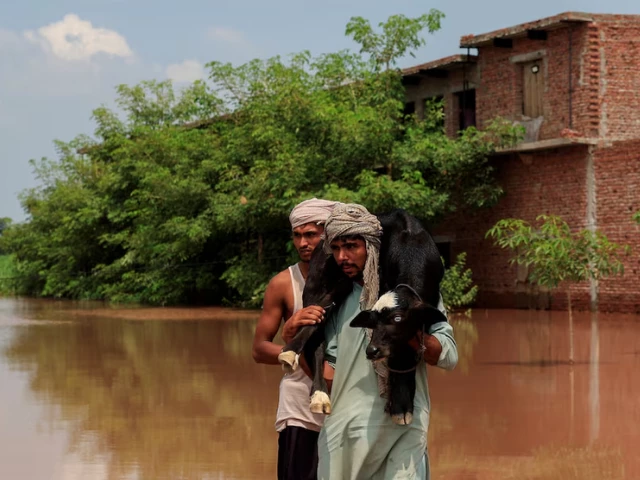Punjab flood crisis exacerbates with 10th monsoon wave
Trimmu, Panjnad at extremely high flood level; 800,000 cusecs of water to enter Guddu tomorrow

With Pakistan now privy to new releases of water from India and the forecast of heavy rainfall in the upper catchments of Punjab, the Provincial Disaster Management Authorities (PDMA) have once again sounded the flood alarm. The 10th wave of monsoon rain is going to engulf the Punjab skies till September 9 with water levels already on the rise, according to PDMA chief Irfan Ali Kathia.
Punjab Relief Commissioner Nabil Javed warned that by September 9, extremely high-level flooding is feared in the Ravi, Sutlej, and Chenab rivers due to heavy upstream rainfall, which could further swell the rivers.
According to numbers released by the Flood Forecasting Division, Trimmu and Panjand heads at the river Chenab are experiencing extremely high level flood with Panjnad seeing a water flow of 609,604 cusecs of water but there is a steady decrease in the water flow. Head Trimmu is experiencing water flow at 543,000 cusecs.
At Marala, River Chenab has a water flow of 84,000 cusecs and Khanki Headworks is at a low-level flood with a water flow of 147,000 cusecs. Similarly, Qadirabad on the Chenab is at 45,000 cusecs, seen as a low-level flood. In the River Sutlej, Ganda Singh Wala is at an extremely high flood level with water flow now at 319,000 cusecs and Suleimank is at a high flood level with water flow at 135,000 cusecs, according to PDMA Punjab.
The river Chenab has wreaked havoc in South Punjab, as the second flood wave enters Multan. About 543,000 cusecs of flood water from Head Trimmu will pass through Multan Head Muhammad Wala Road and the water level is expected to remain high for the next three days. However, despite the flood wave, residents of Qasim Bela, Langrial, and Sher Shah refuse to leave their homes.
Floodwater from the River Chenab has devastated Jalalpur Pirwala, with a red alert issued in the city. The Pakistan Army, Rescue 1122, and other agencies are continuing rescue operations in Jalalpur Pirwala with Rescue 1122 arranging additional boats. So far, 2,000 people have been successfully evacuated with approximately 400,000 people being affected by the floods in the River Chenab.
Head Jasser seems to be the only head on River Ravi that is showing a low-level flood with water outflow at 45,000 cusecs. But Shahdara and Sidhnai are both at a high-level flood with water flows of 90,000 cusecs and 123,000 cusecs, respectively.
Read: Sindh on alert as Punjab floodwaters rush south
Balloki Headworks however, is expected to be on an extremely high level flood risk with water flows reaching a dangerous 139,000 cusecs on the River Ravi.
"On the directions of the Punjab Chief Minister, all relevant departments are on high alert," stated DG PDMA. He further reassured that all resources are being utilised to protect the lives and property of citizens.
The new wave of torrential rainfall has also entered Sindh with high alerts in districts like Mirpur Khas, Shaheed Benazirabad and Larkana, expected to further worsen the upcoming flood threat flowing in from Punjab. Evacuations have started to take place in the province, especially along the riverine. With a whopping 800,000 cusecs of water expected to arrive at Guddu Barrage on September 9 (tomorrow), Chief Minister Murad Ali Shah has assured that Sindh has prepared enough to manage the flood.
The National Disaster Management Authority (NDMA) has released new figures, stating that a staggering 910 people have died this monsoon season, with the highest death rate in Khyber-Pakhtunkhwa with 504 deaths.It was followed by Punjab 234, Sindh 58, Balochistan 26, Gilgit-Baltistan 41, Azad Jammu and Kashmir 38, and Islamabad nine fatalities.
The NDMA also reported 6,180 livestock deaths and damage to 7,848 houses.





















COMMENTS
Comments are moderated and generally will be posted if they are on-topic and not abusive.
For more information, please see our Comments FAQ